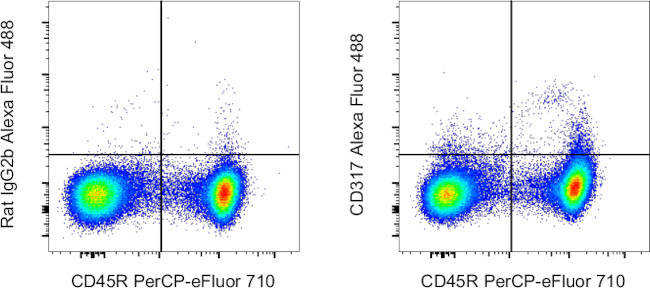Search Thermo Fisher Scientific
Invitrogen
CD317 (BST2, PDCA-1) Monoclonal Antibody (eBio129c (129c)), Alexa Fluor™ 488, eBioscience™
FIGURE: 1 / 1
CD317 (BST2, PDCA-1) Antibody (53-3171-82) in Flow

Product Details
53-3171-82
Species Reactivity
Host/Isotype
Recommended Isotype Control
Class
Type
Clone
Conjugate
Excitation/Emission Max
Form
Concentration
Purification
Storage buffer
Contains
Storage conditions
Shipping conditions
RRID
Product Specific Information
Description: The eBio129c monoclonal antibody reacts with mouse PDCA-1 (BST2, CD317), a specific marker of plasmacytoid dendritic cells (pDC), also known as type I IFN-producing cells (IPC) in the naive mouse. Mouse IPCs are typically CD11c+, CD11b-, B220+, Ly-6C+, and CD62L+. PDCA-1 is predominantly expressed by IPCs in the naive mouse which represents a very minor population (<0.5%) of splenocytes. It is upregulated on numerous cell types following stimulation which triggers an IFN response. PDCA-1 cycles between cell surface and intracellular compartments and may function to regulate trafficking of secreted cytokines. PDCA-1 (BST2) is the protein recognized by the antibody 120G8.
The epitope recognized by eBio129c is distinct from eBio927; thus, the antibodies can be used to costain, purify and identify pDCs.
Applications Reported: This eBio129c (129c) antibody has been reported for use in flow cytometric analysis.
Applications Tested: This eBio129c (129c) antibody has been tested by flow cytometric analysis of mouse splenocytes. This may be used at less than or equal to 0.25 µg per test. A test is defined as the amount (µg) of antibody that will stain a cell sample in a final volume of 100 µL. Cell number should be determined empirically but can range from 10^5 to 10^8 cells/test. It is recommended that the antibody be carefully titrated for optimal performance in the assay of interest.
Excitation: 488 nm; Emission: 519 nm; Laser: Blue Laser
Target Information
BST2 (CD317, HM1.24 antigen, DAMP-2, tetherin) is an integral membrane protein that is involved in the development and growth of B-cells. The surface expression of BST2 on fibroblast cell lines facilitated the stromal cell-dependent growth of DW34, a pre-B-cell line. BST2 is highly expressed during B-cell development, from pro-B precursors to plasma cells, T-cells, monocytes, NK cells and DCs (at protein level), and myeloma cells. Research studies have shown that BST2 also functions as an inhibitor of retrovirus release from human cells whose activity is antagonized by the HIV-1 accessory protein, Vpu. While BST2 causes retention of virions on cell surfaces or endocytosis into BST2-positive compartments, its depletion abolished the viral requirement for Vpu for virus release, an activity that may represent a potential therapeutic strategy for the treatment of HIV/AIDS. Another disease associated with BST2 dysfunction is stomatitis.
For Research Use Only. Not for use in diagnostic procedures. Not for resale without express authorization.
How to use the Panel Builder
Watch the video to learn how to use the Invitrogen Flow Cytometry Panel Builder to build your next flow cytometry panel in 5 easy steps.
References (0)
Bioinformatics
Protein Aliases: Bone marrow stromal antigen 2; BST-2; CD317; DAMP-1 protein homolog; HM1.24 antigen; PDCA-1; tetherin
Gene Aliases: 2310015I10Rik; Bst-2; Bst2; C87040; CD317; DAMP-1; GREG
UniProt ID: (Mouse) Q8R2Q8
Entrez Gene ID: (Mouse) 69550

Performance Guarantee
If an Invitrogen™ antibody doesn't perform as described on our website or datasheet,we'll replace the product at no cost to you, or provide you with a credit for a future purchase.*
Learn more
We're here to help
Get expert recommendations for common problems or connect directly with an on staff expert for technical assistance related to applications, equipment and general product use.
Contact tech support

